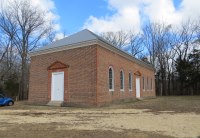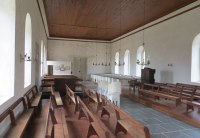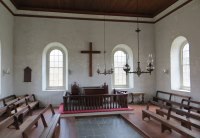Lamb’s Creek Episcopal Church
2025 Service Dates
- August 31 – “Lamb’s Creek Sunday” with 1662 BCP Holy Communion & picnic at 10:00 a.m.
- October 5 – Blessing of the Animals and Holy Eucharist at Lamb’s Creek at 10:00 a.m.
Lamb’s Creek Church is located in an inactive parish (Brunswick) and is currently under the stewardship of Hanover Parish. Brunswick Parish was formed in 1732; its first building known as Muddy Creek Church, was located near the route of the old King’s Highway (now Virginia Route 3) at the present-day boundary of King George and Stafford Counties. It was a small church, probably no more than a log chapel. As the population of the area shifted, it became necessary to build a larger church located more to the east. The new building (c. 1770) was named Lamb’s Creek Church. The church suffered from disuse and neglect after the Revolution but was later refurbished and services were held there regularly until St. John’s was built at the courthouse. During the Civil War, the church suffered abuse by Union soldiers, being used as a stable by the cavalry; some reparations were made after the war. In 1908, services were started again.
Lamb’s Creek has a copy of the very rare “Vinegar” Bible (1716) and an altar edition of the 1662 Book of Common Prayer (1739 printing), which are normally on display at the “Lamb’s Creek Sunday” service.
Pictures from October 1, 2017, Blessing of the Animals service can be found by clicking here.



About Historic Items
Vinegar Bible
From https://intriguing-history.com/the-vinegar-bible/
What is the Vinegar Bible and how did it get its name?
The Vinegar Bible is a version of the King James Bible printed in 1717 by John Baskett, who had attained the title of “printer to the King’s most excellent majesty” in 1709.
John Baskett was to become a powerful character in the world of printing. Born in 1645 in Salisbury, he was the son of a gentleman, Roger Baskett. On 4 December 1682 he was apprenticed to the London stationer Edward Dorrell and after being released from his indentures in 1690 he began to secure his own business.
Printing the Bible was an important and lucrative business of many printing houses including both the Cambridge and the Oxford University Press. In 1711, John Baskett, who was by then the King’s printer, joined the Oxford University Press just at a time when the press was moved from the basement of the Sheldonian Theatre to the newly built Clarendon building next door. By this point in his career, Baskett had gained a reputation for unscrupulously buying up competing Bible printing businesses and absorbing them into his own. The result was a printing business whose finances were precarious and whose legal position was constantly being challenged as Baskett sought to achieve a monopoly.
Baskett’s monopolistic practices were criticised and condemned, the legal challenges he faced from those he sought to control meant that he was often stretched financially, struggling to pay his rent and mortgaging the Bible presses to the hilt. Despite all this, Baskett was, however, successful in many aspects of his printing work. Using the presses in Oxford and London he was able to achieve economies of scale, storing large amounts of printed paper in his London warehouses. He also used local labour, again reducing costs.
He and his supporters wanted to improve both the quality and the appearance of the Bibles being printed. The idea was to produce a folio edition of the King James Bible that would reflect the decisions made by the original translators that had somehow become lost in the intervening years. This Bible would be a presentation piece for use in churches and the homes of the aristocracy. Some of the obsolete language would be added into a glossary. It was meant to be a very special print run. To this end, Baskett had new decorative initials made as well as new engraved plates.
An experienced proof reader, William Denison was employed to ensure the text was as accurate as possible and additional correctors were also drawn into the process. It was noted:
‘Baskett spares no cost nor pains’
In November 1713 the first print run was initiated. The idea was that some of the bibles would be printed on vellum; just three of them were. Others would be printed on fine paper and others on standard. As the process began it was remarked:
‘Whether or no the persons who are to be correctors are really well qualified for the undertaking time will discover’
Prophetic words indeed, for when the bible was eventually published in 1717 it was criticised by the clergy for its omissions and misspellings. It was saved from becoming a complete point of ridicule because in many instances it was intended to be shown rather than read, it would be displayed prominently and would reflect the owner’s wealth. It was richly bound in crimson leather with gilt edging and the new initial beautifully coloured. The large Bible was designed to sit splendidly upon the lectern in a church and of course in this situation it was expected to be read from; alas, the errors it contained made this problematic.
So why the nickname, the Vinegar Bible?
The chapter heading in Luke 20 should read ‘The parable of the vineyard’ instead it reads, ‘the parable of the vinegar’ hence the title the Vinegar Bible.
Text of Civil War Era Letter (unknown source)
Item 54 December 29, 1862
Hd Qrs Haris Light Cavalry
Picket Station at Lambs Cr. Church
15 miles below Falmouth, Va
December 29th 1862
Sister Ada:
I did not expect to write while on picket, but have a Church for quarters and an opportunity. We left camp at 7 AM. yesterday and relieved the 1st Pam Cavalry on picket duty here.
We are to stay three days — have 12 Co’s 4 on the river bank each day while the remainder are bivouaced in woods near this church. It is about 3/4 miles on a line to Rappahannock River. On the opposite bluf the Rebs are hard at work digging breast works in plain view from here.
They are at work like beavers all along the bank up and down while our pickets talk and trade with theirs with freedom always respecting each others feelings and exchange papers and compliments of the day. Its glorious weather. Here lies a large flat composing the valley of the River, cut up into fields of thousands of acres each by cedar hedges and ditches and a road cutting through the centre, parallel to the river, bordered by an ancient highway of cedars in double rows on each side of the ditches which alone would be impassable.
(This road for miles is more pleasant than any st. — lane, or Ave. in Hartford). On either side are the same immense fields of corn shocks in large rows, strips of land between also growing green with newly sown wheat, large wheat fields centred with huge piles of straw and chaff beside the thrashing machines left just as they were in use, and immense streches of neglected fields, where wild carrot seed stalks, wild grass, “life ever lasting” and mullen stalks huddle the space between the old milkweed stalks, corn stalks, on which great lazy owls sit seemingly afraid to turn eyes from the sun till you are just ready to cut them down when they scoot off to some neighboring stalk tempting you to try again. …all large flock of ugly buzzards describe all of circles in the air centering on the carcas of some old horse of mule, the bones being industriously picked. Here and there a flock of quails will flutter away from you very feet and half tame white tailed Rabbits will bob around between the rows. All sorts of little birds are skipping around gathering seeds from various weeds, some of the most beautiful being all red with large top knotts. On the small near the river large flocks of wild ducks dip and paddle / Col. Jones 1st Pa. Cav. shot 12 and got 9 of them at one shot from an old gun yesterday night in hearing and sight of the Rebs opposite bank who halloed to him “Yanks send over a duck.” Etc.
On the other side of the river above the bluff the ground gradually ascends to thickly wooded hills almost smothered from view by the smoke from many camps, where Gen Jacksons and Gen A.P. Hills Corps are encamped. Their infant-y in large squads closely picket the river their Cavalry being farther down where they least expect an attempt to cross by us. On this side of the river, two miles back, is our high ridge woods with pine and oak but we have no infantry near. Only one plantation or house is in sight and that is on a grand scale with long streets of negrow huts white washed neat but their once inmates are sweating over some southern earth work —
As I write Daniel and other officers are singing various tunes sounding gay in this old sanctum, sanctorum.
Daniel bears down the Bass, on tenor and treble the old Church rings although it looks rather rusty as the 1st Pa. Tore out all the slips and left the floor strew with straw, port rinds, hard bread and pistol cartridges, to say nothing about the numerous artistical designed on the walls. This church built in 1740 is 122 years old —of 3 Brick walls— 100 ft long 40 ft. high. Two pulpits, various paintings and inscriptions ornaments etc. Episcopal denomination. Every Officer of the 1st Pa. Cav. should be dismissed from service for what has transpired here they were all drunk christmas (a citizen says) Horses were hitched to heas posts of graves around the church and soldiers have had fires and slept on the graves buring yard fence etc. It’s a rong way to reunite the states alowing such officers
[letter end – obvious missing text]
